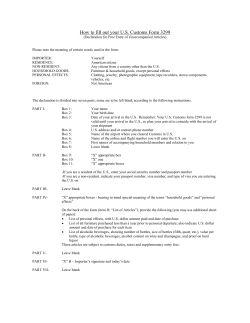
Solutions to COMP9334 Week 6 Sample Problems
Solutions to COMP9334 Week 6 Sample Problems Problem 1: For Week 3’s sample problem 1, find the response time in each option using queueing analysis. Solution: (a) This option is an M/M/1 queue with λ = 0.02 customers per msec and µ = 0.05 customers per msec. Using the M/M/1 mean response time formula, we have T = 1 1 = = 33.3 msec µ−λ 0.05 − 0.02 (b) In this option, the arrival rate at each queue is half of the system arrival rate. Effectively, we have two M/M/1 queues, each with λ = 0.01 customers per msec and µ = 0.025 customers per msec. Using the M/M/1 mean response time formula, we have 1 1 T = = = 66.7 msec µ−λ 0.025 − 0.01 (c) This option is effectively an M/M/2 queue with λ = 0.02 customers per msec, µ = λ 0.025 customers per msec, A = λ/µ = 0.8, and ρ = 2µ = 0.4. Using the M/M/m mean response time formula and letting m = 2, we have C(A, 2) = and therefore T = A2 2! (1 − ρ)(1 + A) + A2 2! C(A, 2) 1 + = 47.6 msec mµ − λ µ 1 Problem 2: Show that the Erlang C formula and the Erlang B formula have the following relationship: E(A, m) . C(A, m) = 1 − ρ [1 − E(A, m)] Solution: (1 − ρ) 1 = C(A, m) Pm−1 Ak k=0 Am m! k! + Am m! = 1−ρ +ρ E(A, m) Problem 3: An Internet Service Provider has 4 dial-up ports. Connection requests follow a Poisson arrival process with mean arrival rate of 3 requests per hour. The session duration of each connection request is exponentially distributed with a mean of 1.5 hours. What is the probability that a connection request will be rejected? Solution: This is effectively an M/M/4/4 system with λ = 3 requests per hour, 1/µ = 1.5 hours, and A = λ/µ = 4.5. The probability that a connection request is blocked is given by the Erlang B formula E(A, m) = Am m! Pm Ak k=0 k! = 4.54 4! P4 4.5k k=0 k! = 0.3567 Alternatively, we have 1 = E(A, m) Ak k=0 k! Am m! Pm−1 Ak Pm = k=0 k! Am m! + Am m! = m +1 AE(A, m − 1) Therefore, we can compute E(A, m) using the following recursive formula E(A, k) = AE(A, k − 1) , k = 1, 2, . . . , m k + AE(A, k − 1) (1) with the initial condition E(A, 0) = 1. Note that the initial condition E(A, 0) = 1 holds because if the number of servers in the system is 0, all customers will be blocked, so the blocking probability is 1. Using (1), for A = 4.5, m = 4, we have: E(A, 1) = AE(A, 0) 4.5 = = 0.8182 1 + AE(A, 0) 1 + 4.5 AE(A, 1) 4.5 × 0.8182 = = 0.6480 2 + AE(A, 1) 2 + 4.5 × 0.8182 AE(A, 2) 4.5 × 0.6480 E(A, 3) = = = 0.4929 3 + AE(A, 2) 3 + 4.5 × 0.6480 AE(A, 3) 4.5 × 0.4929 E(A, 4) = = = 0.3567 4 + AE(A, 3) 4 + 4.5 × 0.4929 E(A, 2) = 2
© Copyright 2025





















